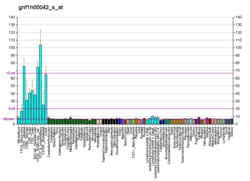MAPKAPK5
| MAPKAPK5 | |||||||||||||||||||||||||||||||||||||||||||||||||||
|---|---|---|---|---|---|---|---|---|---|---|---|---|---|---|---|---|---|---|---|---|---|---|---|---|---|---|---|---|---|---|---|---|---|---|---|---|---|---|---|---|---|---|---|---|---|---|---|---|---|---|---|
| Identifiers | |||||||||||||||||||||||||||||||||||||||||||||||||||
| Aliases | MAPKAPK5, MAPKAP-K5, MK-5, MK5, PRAK, mitogen-activated protein kinase-activated protein kinase 5, MAPK activated protein kinase 5, NCFD | ||||||||||||||||||||||||||||||||||||||||||||||||||
| External IDs | OMIM: 606723; MGI: 1333110; HomoloGene: 69077; GeneCards: MAPKAPK5; OMA:MAPKAPK5 - orthologs | ||||||||||||||||||||||||||||||||||||||||||||||||||
| |||||||||||||||||||||||||||||||||||||||||||||||||||
| |||||||||||||||||||||||||||||||||||||||||||||||||||
| |||||||||||||||||||||||||||||||||||||||||||||||||||
| |||||||||||||||||||||||||||||||||||||||||||||||||||
| |||||||||||||||||||||||||||||||||||||||||||||||||||
| Wikidata | |||||||||||||||||||||||||||||||||||||||||||||||||||
| |||||||||||||||||||||||||||||||||||||||||||||||||||
MAP kinase-activated protein kinase 5 is an enzyme that in humans is encoded by the MAPKAPK5 gene.[5][6] The protein encoded by this gene is a member of the serine/threonine kinase family. In response to cellular stress and proinflammatory cytokines, this kinase is activated through its phosphorylation by MAP kinases, including MAPK1/ERK, MAPK14/p38-alpha, and MAPK11/p38-beta. In vitro, this kinase phosphorylates heat shock protein HSP27 at its physiologically relevant sites. Two alternately-spliced transcript variants of this gene encoding distinct isoforms have been reported.[6]
A link between Alzheimer's disease and reduced levels of MAPKAPK5 has been proposed. Clinical trials may confirm if this is the case.
References
- ^ a b c GRCh38: Ensembl release 89: ENSG00000089022 – Ensembl, May 2017
- ^ a b c GRCm38: Ensembl release 89: ENSMUSG00000029454 – Ensembl, May 2017
- ^ "Human PubMed Reference:". National Center for Biotechnology Information, U.S. National Library of Medicine.
- ^ "Mouse PubMed Reference:". National Center for Biotechnology Information, U.S. National Library of Medicine.
- ^ New L, Jiang Y, Zhao M, Liu K, Zhu W, Flood LJ, Kato Y, Parry GC, Han J (Jul 1998). "PRAK, a novel protein kinase regulated by the p38 MAP kinase". EMBO J. 17 (12): 3372–84. doi:10.1093/emboj/17.12.3372. PMC 1170675. PMID 9628874.
- ^ a b "Entrez Gene: MAPKAPK5 mitogen-activated protein kinase-activated protein kinase 5".
Further reading
- de Carvalho MG, McCormack AL, Olson E, et al. (1996). "Identification of phosphorylation sites of human 85-kDa cytosolic phospholipase A2 expressed in insect cells and present in human monocytes". J. Biol. Chem. 271 (12): 6987–97. doi:10.1074/jbc.271.12.6987. PMID 8636128.
- Börsch-Haubold AG, Bartoli F, Asselin J, et al. (1998). "Identification of the phosphorylation sites of cytosolic phospholipase A2 in agonist-stimulated human platelets and HeLa cells". J. Biol. Chem. 273 (8): 4449–58. doi:10.1074/jbc.273.8.4449. PMID 9468497.
- Ni H, Wang XS, Diener K, Yao Z (1998). "MAPKAPK5, a novel mitogen-activated protein kinase (MAPK)-activated protein kinase, is a substrate of the extracellular-regulated kinase (ERK) and p38 kinase". Biochem. Biophys. Res. Commun. 243 (2): 492–6. doi:10.1006/bbrc.1998.8135. PMID 9480836.
- Sudo T, Maruyama M, Osada H (2000). "p62 functions as a p38 MAP kinase regulator". Biochem. Biophys. Res. Commun. 269 (2): 521–5. doi:10.1006/bbrc.2000.2333. PMID 10708586.
- Hefner Y, Borsch-Haubold AG, Murakami M, et al. (2001). "Serine 727 phosphorylation and activation of cytosolic phospholipase A2 by MNK1-related protein kinases". J. Biol. Chem. 275 (48): 37542–51. doi:10.1074/jbc.M003395200. PMID 10978317.
- Zhou J, Lottenbach KR, Barenkamp SJ, et al. (2002). "Recurrent variable region gene usage and somatic mutation in the human antibody response to the capsular polysaccharide of Streptococcus pneumoniae type 23F". Infect. Immun. 70 (8): 4083–91. doi:10.1128/IAI.70.8.4083-4091.2002. PMC 128163. PMID 12117915.
- Perfetti V, Casarini S, Palladini G, et al. (2002). "Analysis of V(lambda)-J(lambda) expression in plasma cells from primary (AL) amyloidosis and normal bone marrow identifies 3r (lambdaIII) as a new amyloid-associated germline gene segment". Blood. 100 (3): 948–53. doi:10.1182/blood-2002-01-0114. PMID 12130507.
- Knebel A, Haydon CE, Morrice N, Cohen P (2002). "Stress-induced regulation of eukaryotic elongation factor 2 kinase by SB 203580-sensitive and -insensitive pathways". Biochem. J. 367 (Pt 2): 525–32. doi:10.1042/BJ20020916. PMC 1222910. PMID 12171600.
- Strausberg RL, Feingold EA, Grouse LH, et al. (2003). "Generation and initial analysis of more than 15,000 full-length human and mouse cDNA sequences". Proc. Natl. Acad. Sci. U.S.A. 99 (26): 16899–903. Bibcode:2002PNAS...9916899M. doi:10.1073/pnas.242603899. PMC 139241. PMID 12477932.
- New L, Jiang Y, Han J (2004). "Regulation of PRAK subcellular location by p38 MAP kinases". Mol. Biol. Cell. 14 (6): 2603–16. doi:10.1091/mbc.E02-08-0538. PMC 194907. PMID 12808055.
- Ota T, Suzuki Y, Nishikawa T, et al. (2004). "Complete sequencing and characterization of 21,243 full-length human cDNAs". Nat. Genet. 36 (1): 40–5. doi:10.1038/ng1285. PMID 14702039.
- Gerhard DS, Wagner L, Feingold EA, et al. (2004). "The status, quality, and expansion of the NIH full-length cDNA project: the Mammalian Gene Collection (MGC)". Genome Res. 14 (10B): 2121–7. doi:10.1101/gr.2596504. PMC 528928. PMID 15489334.
- Sun P, Yoshizuka N, New L, et al. (2007). "PRAK is essential for ras-induced senescence and tumor suppression". Cell. 128 (2): 295–308. doi:10.1016/j.cell.2006.11.050. PMID 17254968. S2CID 12383872.
- v
- t
- e
Serine/threonine-specific protein kinases (EC 2.7.11.21-EC 2.7.11.30) | |||||||||||||||||||||
|---|---|---|---|---|---|---|---|---|---|---|---|---|---|---|---|---|---|---|---|---|---|
| |||||||||||||||||||||
Dual-specificity kinases (EC 2.7.12) | |||
|---|---|---|---|
| |||
 | This article on a gene on human chromosome 12 is a stub. You can help Wikipedia by expanding it. |
- v
- t
- e




















